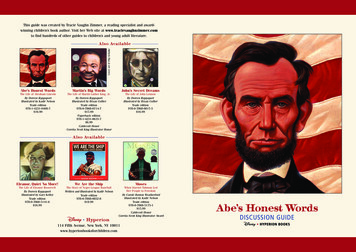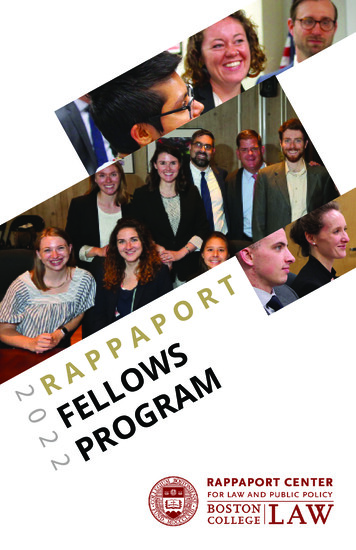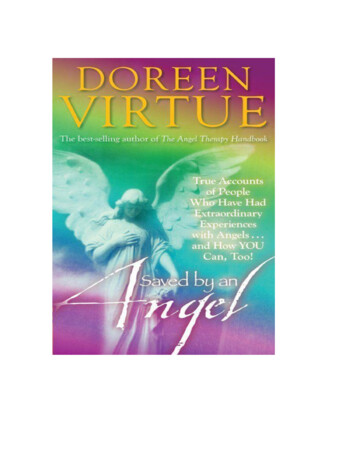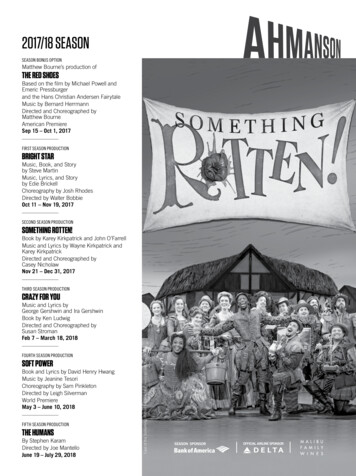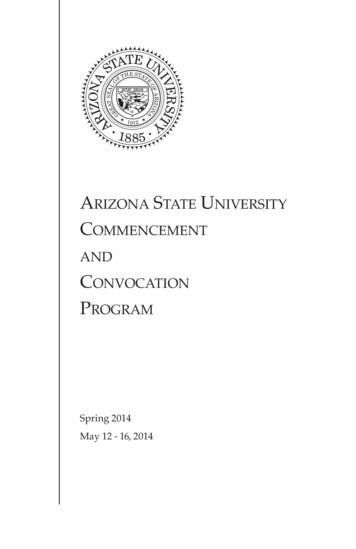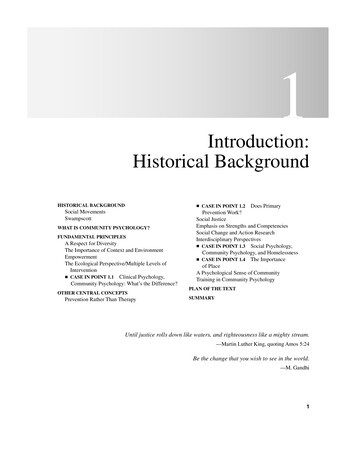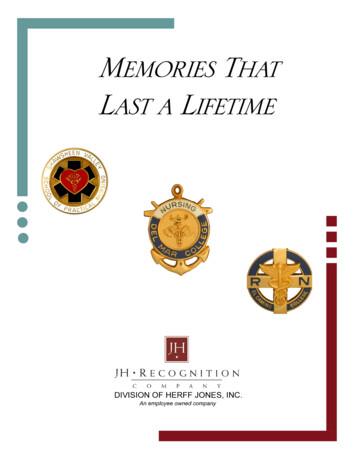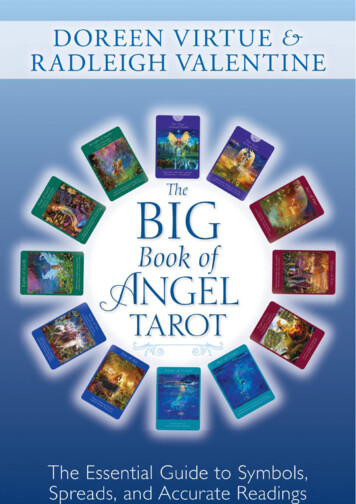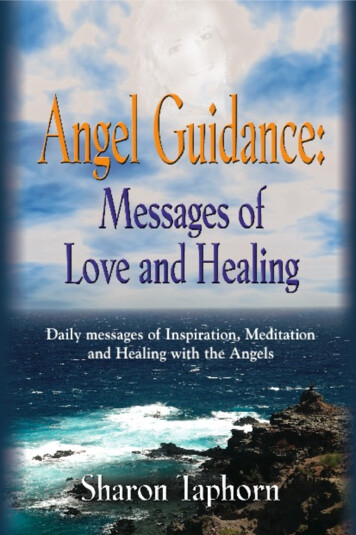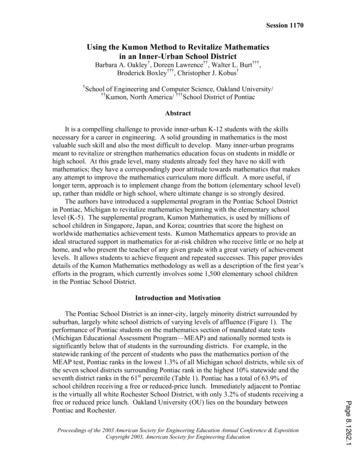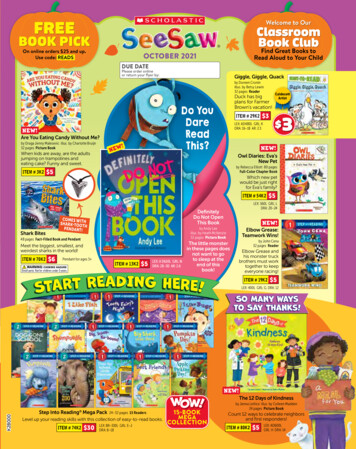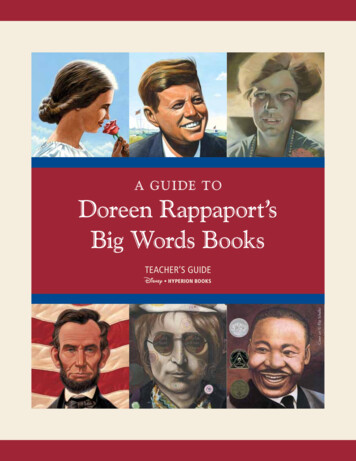
Transcription
A GUI DE TODoreen Rappaport’sBig Words BooksTEACHER’S GUIDECover art Flip SchulkeDisney s (90%2)/. "// 3B
About Doreen Rappaport’sBig Words Booksan accessible, thorough introduction to the lives of our nation’smost compelling historical figures. Drawing upon quotes from hersubjects, and a variety of sources, Rappaport’s lyrical prose createsvery human portraits of Martin Luther King, Jr., John Lennon,Keller. By beginning from childhood and showing the obstaclesthat each subject faced on their path of accomplishment, the booksallow readers to admire and identify with people who might oncehave seemed difficult to relate to. Illustrated by an impressiveroster of award-winning illustrators, each person and their world isrecreated with accuracy and in stunning detail. A thorough list ofsources and suggested books for further reading is included in eachbook to help readers expand upon their newfound knowledge.Common Core AlignmentThis guide is aligned with the College and Career ReadinessAnchor Standards (CCR) for Reading (Informational Text),Cover art Flip Schulkefoundation for the grade level-specific Common Core StateStandards. Each question and activity in this guide includesa reference for the CCR strand, domain, and standard that isaddressed. To support instruction also reference your grade-levelspecific Common Core State Standards to scaffold the questionsfor your students.2
Helen’s Big World: The Life of Helen KellerAbout the Bookadvocating for all people to have equal rights. This powerful storystory with the world after receiving help from a dedicated teacher.The road was difficult because she had to learn to navigate theenvironment around her, communicate with others, read, andwrite. Today, her resilience, passion, and wisdom continue toinspire people with and without disabilities.Pre-Reading ActivitiesAnticipation GuideStep 1: Display the table below and ask students to decide as a group or individually whether the answer istrue or false. If time permits, also ask students why they selected a particular answer.Step 2: After the completion of the story, refer back to the chart and ask students to answer the questionsagain. (Reading: Range of Reading and Level of Text Complexity: RI.CCR.10)BEFORESTATEMENTAFTERwoman who could not hear.Individuals who cannot see willnever be able to write or read.fighting for all people to haveequal rights.worked with her while she wasa child and adult.Only elderly people can losetheir ability to hear or see.3
VocabularyStep 1: Introduce the key terms, definitions, and questions in the table to help students better understandindividuals with specific types of disabilities.Step 2: After introducing the vocabulary make a connection to the text by presenting students with therelates to the key terms in the table? (Reading: Key Ideas and Details: RI.CCR.4)KEYTERMSIndividuals withVisual ImpairmentsIndividuals with4DEFINITIONA person who can eithersee very little or has novision at all. If a person hasno vision at all he or she isconsidered blind.A person who can only hearsome sounds, which maysound unclear or muffled.A person is considered deafif he or she cannot hearany sound.QUESTIONS: ActivatingBackground Knowledgebetween a person who wearsglasses and a person with avisual impairment?Can you think of any famousactors or singers who arevisually impaired?Do you know anyone whowears a hearing aid?Can you think of inventionsthat help individuals withhearing impairments (e.g.,closed captions, flashingcrosswalk signs, books inBraille, etc .)?
Discussion QuestionsEARLY YEARS1frustrations? (Reading: Integration of Knowledge and Ideas: RI.CCR.8)2ideas/experiences and details from the text to answer the question. (Reading: Key Ideas and Details:RI.CCR.1)3(Language: Vocabulary Acquisition andUse: L.CCR.5)4around her? Give examples from the story. (Reading: Key Ideas and Details: RI.CCR.1)5this information help the reader? (Reading: Integration of Knowledge and Ideas: R.CCR.7)6read? (Reading: Integration of Knowledge and Ideas: RI.CCR.8)ADULT YEARS1(Reading: Key Ideas and Details: RI.CCR.1)2occulists,she has always abused her eyes for my sake.” Use the context clues in the quote to figure out whatthe word occulists(Language: Vocabulary Acquisition and Use: L.CCR.4)3from the story show that her life made a difference? (Reading: Key Ideas and Details: RI.CCR.2)4today? Give examples from the book. (Reading: Key Ideas and Details: RI.CCR.1)5
Post-reading Assignment(Reading: Integrationof Knowledge and Ideas: RI.CCR.9)Across the CurriculumWritingyou do or do not agree. Be sure to support your argument with an introduction, multiple reasons, and aconcluding statement. (Writing: Text Types and Purposes: W.CCR.1)6
MathUse the timeline of important dates, which are located on the final pages of Helen’s Big World to calculate(Reading: Integration ofKnowledge and Ideas: RI.CCR.7)MusicSince many individuals with hearing impairments cannot listen to music by using their ears, they mustrely on vibrations to enjoy a song. Insert earplugs into your ears and use the vibrations to “hear” the song.Research the use of vibrations online and write a report that explains how vibrations allow people tolisten to music. Be sure to include an introduction, develop the topic with facts, and provide a concludingstatement. (Writing: Text Types and Purposes: W.CCR.2)Home-School Connectionsomeone at home, use the Internet to research the history of ASL and the Manual Language Chart inHelen’s Big World to create an informational book on each letter. In class with a partner present your workand discuss what you each tried to teach your audience. (Writing: Production and Distribution of Writing:W.CCR.6)7
Jack’s Path of Courage: The Life of John F. KennedyAbout the BookAs a boy, Jack Kennedy was frequently ill and fought to stay out of thehero, U.S. senator, and then a most vital American president. But thisand faced tough decisions that affected the country and the world.Despite these difficulties, John F. Kennedy forged a path that madecompassion, determination, and a tremendous amount of courage.Jack’s Path of Courage follows John F. Kennedy from childhood toclose to him with her own lyrical prose to create a moving portrait of a beloved figure. Matt Tavares’sstunning artwork vividly depicts this unique time in history.Pre-readingDo you agree with this quote from Jack Kennedy: “Things do not happen. Things are made to happen”?answer? (Reading: Integration of Knowledge and Ideas: RI.CCR.1)students to engage in a small group discussion with agreed-upon rules as you fill in the chart. (Speakingand Listening: Presentation of Knowledge and Ideas: SL.CCR.1)about JFK8about JFKabout JFK
Discussion GuideEARLY YEARS1love best? Do you think Jack’s habit of reading a lot as a young person helped him become successful?(Reading: Key Ideas and Details: RI.CCR.1)2(Reading: Key Ideas and Details: RI.CCR.1)3text to support your answer. (Reading: Key Ideas and Details: RI.CCR.3)4the text and illustrations from the book to explain your answer. (Reading: Integration of Knowledge andIdeas: RI.CCR.7)9
A LEADER AND HERO1(Reading: Key Ideasand Details: RI.CCR.3)2because of this loss (the effect)? (Reading: Key Ideas and Details: RI.CCR.3)3with people. (Reading: Key Ideas and Details: RI.CCR.1)4 Do you think Jack’s second book, Profiles in Courage, helped shape him as a politician and leader?(Reading: Key Ideas and Details: RI.CCR.1)510Profile in Couragecourageous? (Reading: Key Ideas and Details: RI.CCR.2)
PRESIDENT1(Reading: Integration of Knowledge and Ideas:RI.CCR.8)2connection. (Reading: Key Ideas and Details: RI.CCR.1)3(Reading: Key Ideas and Details: RI.CCR.1)4show what other conflicts he faced as president? (Reading: Craft and Structure: RI.CCR.5)5Use examples from the text to support your answer. (Reading: Key Ideas and Details: RI.CCR.1)Across the CurriculumReadingis the most important thing to know about JFK? (Speaking and Listening: Presentation of Knowledge andIdeas: SL.CCR.1)WritingInspired by this book, write a biography of another U.S. president in this same style by using technologyto design the book and create illustrations. (Writing: Production and Distribution of Writing: W.CCR.6)HistoryAlso, add three important events from history on the timeline. Be sure to include all the sources thatyou used to find your timeline information. (Writing: Research to Build and Present Knowledge: W.CCR.8)11
Eleanor, Quiet No More: The Life of Eleanor RooseveltAbout the Bookfor her beliefs. But she still spoke up, to change things thatneeded changing, and to help those who felt too vulnerableto speak for themselves. Doreen Rappaport lyrically combinespoignant biographical details with Eleanor Roosevelt’s words,while Gary Kelley’s moving illustrations re-create a true first inFirst Ladies, and the world she helped make better. Thequotes in this book have been taken from Eleanor Roosevelt’sautobiographies, her letters to Franklin, speeches before variousDemocratic women’s groups, her newspaper columns, and theUnited Nations Universal Declaration of Rights.Discussion Questions1(Reading:Craft and Structure: RI.CCR.5)2(Reading: Key Ideas andDetails: RI.CCR.1)3(Reading: Key Ideas andDetails: RI.CCR.1)4(Reading: Integration of Knowledge and Skills:RI.CCR.7)5(Reading: KeyIdeas and Details: RI.CCR.1)12
Across the CurriculumReadingMany people may ask, what type of person was Eleanor? Create a character web based on the life of EleanorRoosevelt. Brainstorm a list of adjectives to describe Eleanor (for instance, brave) and then use example fromthe book that support why you chose each adjective. (Language: Vocabulary Acquisition and Use: L.CCR.5)WritingChoose your favorite Eleanor Roosevelt quotation from the book and write your opinion about the quote.you’ve learned to your own life? (Writing: Text Types and Purposes: W.CCR.1)Mentor Textnext piece? (Reading: Craft and Structure: RI.CCR.3)13
MathResearch the cost of living during the Great Depression and the cost of similar goods and services now.Also, find the average salary of Americans during each time period. Create an essay that compares the costof living and salaries of Americans then and now. Be sure to include a list of your sources. (Writing: Researchto Build and Present Knowledge: W.CCR.8)Science/HealthPresident Franklin Roosevelt was stricken with polio, but today vaccines have nearly eradicated the disease.you learned to a partner or small group in class. (Speaking and Listening: Presentation of knowledge and Ideas:SL.CCR.4)Current EventsResearch the New Deal using books and technology. Find out what kinds of projects FDR initiated to helpBarack Obama. In what ways are they similar? In what ways are they different? (Writing: Research to Build andPresent Knowledge: W.CCR.7)14
Abe’s Honest Words: The Life of Abraham LincolnAbout the BookFrom the time he was a young man, Abraham Lincoln was painedby the cruelty and evil of the institution of slavery. A voraciousreader, Lincoln spent every spare moment of his days filling hismind with knowledge — from history to literature to mathematics—that helped him make difficult and crucial decisions when heeventually became president. Lincoln guided the nation through along and bitter civil war and penned the document ending slaveryin the United States. Doreen Rappaport’s accessible, absorbingprose and Kadir Nelson’s powerful illustrations reveal the passionfor humanity that defined Lincoln’s life.Discussion Questions1this first sentence? Use illustrations and words from the book to retell the order of events. (Reading:Key Ideas and Details: RI.CCR.3)2include them? (Reading: Craft and Structure: RI.CCR.5)3to support your answer. (Reading: Key Ideas and Details: RI.CCR.1)4and led him to become president. (Reading: Key Ideas and Details: RI.CCR.3)15
5negative views of him? Give examples from the text. (Reading: Key Ideas and Details: RI.CCR.1)Across the CurriculumReadingIn the following chart, pull important facts, quotes, or details from the book and list them on the leftside. On the right, share your reactions, including feelings, thoughts, memories, or connections you madeof the story. (Reading: Key Ideas and Details: RI.CCR.2)Important Quotes, Facts, or DetailsConnections and ReactionsEx.loved words.”much schooling, but his passion for educationcame from reading books.Musicdiscuss what the lyrics mean and how the message of each song is similar and different. (Reading: Integrationof Knowledge and Ideas: RI.CCR.9)Social Studiescategories by labeling which states fought for the Union and which for the Confederacy. (Writing: Productionand Distribution of Writing: W.CCR.8)16
Dates to RememberFebruary 12, 2009U.S. states, but even if it’s not, you can celebrate the anniversary of his birth.November 19, 1863 is the date he gave the Gettysburg Address; students may enjoy revisiting the speechon or around that date.Other important dates of interest can be found at the back of Abe’s Honest Words. Review the timeline and(Reading: Integration of Knowledgeand Ideas: RI.CCR.7)17
John’s Secret Dreams: The Life of John LennonAbout the Booka rebel, a genius, an innovator, and a peace activist. From a younglife. As a follow-up to their award-winning title, Martin’s Big Words,Doreen Rappaport and Bryan Collier combine narrative and songlyrics, cut-paper collage and watercolor art to capture the energyand the essence of a man whose vision and creative genius continueto inspire people today.Discussion Questions1 John Lennon is quoted on the first page of the book as saying, “I like to write about me, because Iknow about me.” Based on examples from the book, what does this mean? Do you like to write about(Reading: Key Ideas andDetails: RI.CCR.1)18
2 Even though his Aunt Mimi discounted John’s dreams of being an artist or musician, he stuck with it.(Reading:Key Ideas and Details: RI.CCR.1)3would you choose if you wrote a biography about someone? (Reading: Key Ideas and Details: RI.CCR.2)4 A palette is the colors that an artist chooses to show the feelings of a picture. Choose and compare two(Reading:Integration of Knowledge and Ideas: RI.CCR.9)5story, how do they relate to his life? Do they remind you of any other music or poetry you’ve listened to?(Reading: Key Ideas and Details: RI.CCR.1)19
Across the CurriculumLanguage Art(Writing: Range of Writing:W.CCR.10)John Lennon and Paul McCartney collaborated on song lyrics. Try your hand at collaborating with afriend: You write one line and your partner writes the next. Record the song with your partner and playit for the class. Also, remember to explain the meaning of your song to everyone. (Speaking and Listening:Presentation of Knowledge and Ideas: SL.CCR.3)HistoryUse the book to create interview questions for someone who remembers when the Beatles were popular.Ask at least five questions about the time in which the Beatles were most popular. (Reading: Key Ideas andDetails: RI.CCR.1)Use the book to make a timeline of historical events that span John Lennon’s lifetime. Then add notationsabout major events in John’s life. In a short journal (or classroom discussion) explain how you think someof them are related. (Reading: Key Ideas and Details: RI.CCR.3)Art and MusicIllustrate the main idea and important details of any Beatles or John Lennon song. Use any technique youprefer, but consider a collage inspired by Collier’s illustrations. (Reading: Key Ideas and Details: RI.CCR.2)Throw a 60s party featuring the music, clothing, and sayings of the period.20
Martin’s Big Words: The Life of Dr. Martin Luther King, Jr.Cover art Flip SchulkeAbout the BookThis picture book biography of Dr. Martin Luther King, Jr. bringshis life and the profound nature of his message to young childrenthrough his own words. Martin Luther King, Jr., was one of themost influential and gifted speakers of all time. Doreen Rappaportuses quotes from some of his most beloved speechesto tell the story of his life and his work in a simple, direct way.Bryan Collier’s stunning collage art combines watercolor paintingswith vibrant patterns and textures. A timeline and a list ofbiography of Dr. King.Pre-reading(Speaking and Listening: Comprehension and Collaboration: SL.CCR.1)Genre: Biography(Reading: Key Ideas and Details: RI.CCR.1)important thing to do? Pick one quote and explain the significance. (Reading: Integration of Knowledge andIdeas: RI.CCR.1)Illustrationdecided not to put any words on the front cover of the book? (Reading: Integration of Knowledge and Ideas:RI.CCR.7)idea important to the civil rights movement? Use examples from the text to support your answer. (Reading:Key Ideas and Details: RI.CCR.1)Theme: Equality21
some specific examples in education, employment, and public settings that needed to change for equality?Use the book to provide specific examples that support your answer. Are there still things that need to bechanged? (Reading: Key Ideas and Details: RI.CCR.1)Settingwhere you found your answer in the text. (Reading: Integration of Knowledge and Ideas: RI.CCR.7)Across the CurriculumLanguage ArtsUse technology to research another hero or major figure of the civil rights movement and write abiography. Use a style similar to that of Rappaport— allowing your subject to speak for him or herselfwhenever possible. (Writing: Research to Build and Present Knowledge: W.CCR.7)(Writing: Rangeof Writing: W.CCR.10)VocabularyDefine the following words and draw a picture that will help you remember what they mean: hymn, citizen,courage, protest, rights, movement, peace, freedom, and segregation. Use your text to find how the words are usedin the story. (Reading: Craft and Structure: RI.CCR.4)Social StudiesIn small groups, research one of the following events or people from the civil rights movement andcreate a pamphlet about it. Include who was involved,where it took place, why it is important, and whateffect it had. (Writing: Production and Distributionof Writing: W.CCR.7)Brown vs. Board of EducationRosa ParksMontgomery bus boycottRuby BridgesBombing of the 16th Street Baptist Churchin Birmingham, AlabamaCivil Rights ActMarch on Birmingham, AlabamaVoting Rights ActTwenty-fourth Amendment22
ArtExplore the technique of collage and depict another scene or person from the civil rights movement byprinting online pictures and adding captions to the images. Present the collage to the class and answer anyquestions that classmates have about the scene. (Speaking and Listening: Presentation of Knowledge and Ideas:SL.CCR.4)Science/HealthDr. King worked hard to help people earn a living wage, to make enough money to help their families getout of poverty. Research what effects poverty has on children’s health and education. Make a poster thatincludes paragraphs and pictures about what you learn. (Writing: Research to Build and Present Knowledge:W.CCR.7)Musicabout why you think they were important. Record one of the songs on tape, play it for your classmates, andexplain the significance. (Speaking and Listening: Presentation of Knowledge and Ideas: SL.CCR.5)“Lift Ev’ry Voice and Sing”“Oh, Freedom”“Ain’t Gonna Let Nobody Turn Me ’Round”23
Biography Projectas a class, brainstorm the topics that are most important to find out about a person. Or, you could createa web on the following topics: Person’s name, early years, major accomplishments, education, sports andhobbies, etc. (Writing: Production and Distribution of Writing: W.CCR.7)Discussion Questions or Writing PromptsIf you are using the questions as writing prompts be sure that students include the following: Anintroduction, multiple reasons that support the main idea or opinion, and a concluding statement.1(Writing: Text Types and Purposes: W.CCR.1)2you remember about this individual a year from now? Five years from now? (Writing: Text Types andPurposes: W.CCR.2)3favorite text. (Reading: Key Ideas and Details: RI.CCR.1)Research Assignmentthem and include an introduction, at least five important facts, and a conclusion. Share your article with aclassmate and discuss why your selected person is important. (Writing: Production and Distribution of Writing:W.CCR.6)each story. Use online sources and related informational texts to research the topic. (Writing: Research toBuild and Present Knowledge: W.CCR.7)Great research is best done with primary sources rather than secondary ones. Primary sources are actualletters, notes, diaries, pictures, or other firsthand documentation of a person’s life. As you research a(Writing: Research to Build and Present Knowledge: W.CCR.8)24
MusicResearch the type of music that was popular during your subject’s life. You could look at the year theyrhythms, and style? Create and record a song that you believe would have been popular during that timeperiod. (Speaking and Listening: Presentation of Knowledge and Ideas: SL.CCR.5)ArtCreate a piece of sculpture or collage that best represents the person you are studying. Use images thatshow important aspects of their life. Present your sculpture to the class and use it to tell the story of theselected person’s life. Be sure to answer any questions that classmates ask about the sculpture at the end ofthe presentation. (Speaking and Listening: Presentation of Knowledge and Ideas: SL.CCR.6)25
About the AuthorDoreen Rappaport (www.doreenrappaport.com) is the recipient of TheWashington Post Children’s Book Guild Award for Lifetime Achievementfor the writing of non-fiction. Among her many award-winning books areMartin’s Big Words: The Life of Dr. Martin Luther King, Jr., illustrated by BryanAbe’s Honest Words: The Life of Abraham Lincoln, illustrated by Kadir NelsonShe lives and writes in upstate New York.Q& A with Doreen Rappaport1 Can you describe your process for bringing your biographies to life?The idea to tell a person’s life including his/her words came from writing the first biography on MartinLuther King, Jr. I thought about what was the essence of Dr. King, how did he communicate his ideasand beliefs to the world, how did he reach other Americans, many who were not concerned with thedifficulties of being black in the United States. I worked in the Civil Rights Movement in the South andwell acquainted with the power of other of Dr. King’s speeches. So as I was researching the details ofhis life, I heard his words. I believe in the power of words to convince, to persuade, to clarify. I wantedchildren to hear words that inspire, that confront and declare the values I believe in, and so as I shapedmy narrative for my biographies, it was natural to include words in all of them.2 What have you learned about writing over your career?younger children, for you must simplify complex ideas and use fewer words, always taking care not tothe time between the drafts, the time you let the manuscript sit waiting for your next revision, is crucialtime for you to get a fresh eye on what works and what doesn’t. It takes time. You must go over and overyour words. You must have the courage to cut out phrases you love if they do not belong.3 Why do you think it is important for young people to study biography?Like all of us, the people I write about struggled with how to overcome hardship, how to shape theirlives, how to confront contradictions, and how to make meaningful choices to lead lives of integrity.Martin Luther King, Jr. gathered inner strength from his early surroundings despite the degradationof racial segregation. John Lennon dealt with the pain of his abandonment by his mother by secretlydreaming of being a poet and musician. Eleanor Roosevelt had the luck to have a great teacher whohelped Eleanor value herself and opened her mind to “think” and “respond” to the world around her.Abraham Lincoln refused to let his lack of formal education limit his life. John F. Kennedy struggledto create his own path out of the shadow of his older brother. I know lots of children and adults whoface and faced similar problems. I believe reading about people’s lives and struggles helps young peopleunderstand their own capacities for change and that change is possible.26
About the IllustratorsBryan CollierMartin’s Big Words, John’s Secret Dreamswinner Bryan Collier has created art for many award-winning children’sbooks, including his master achievements: Rosa; Martin’s Big Words:The Life of Dr. Martin Luther King, Jr.; Freedom River; and John’s Secret Dreams:The Life of John Lennon.Kadir NelsonAbe’s Honest WordsKadir Nelson is the illustrator of many books for children, includingMoses: When Harriet Tubman Led Her People to Freedom by Carole Bostonand a Coretta Scott King Illustrator Award winner, and Ellington Was Nota StreetWe Are the Ship: The Story of Negro LeagueBaseball, which won the Sibert Medal, a Coretta Scott King Author Award,Gary KelleyEleanor, Quiet No MoreGary Kelley earned a degree in art from the University of Northern Iowa inCedar Falls. Among his many awards are twenty-three gold and silver medalsillustration. Gary lives in Cedar Falls.Matt TavaresHelen’s Big World, Jack’s Path of CourageMatt Tavares is the illustrator several books, including ’Twas the Night BeforeChristmas; Jack and the Beanstalk written by E. Nesbit; Iron Hans: A Grimms’Fairy Tale, retold by Stephen Mitchell; and Lady Liberty: A Biography, writtenby Doreen Rappaport.27
GUIDE WRITERSDawn Jacobs has a doctorate in Special Education: Learning Disabilities, and works to improve academic outcomesfor all students through teacher development, instructional design, and research in the areas of response to intervention,social support, and parent involvement.Tracie Vaughn Zimmer is an award-winning children’s author and literacy specialist.www.disneyhyperionbooks.com.Doreen Rappaport’s Big Words BooksHelen’s Big WorldJack’s Path of CourageEleanor, Quiet No MoreThe Life of Helen KellerIllustrated by Matt TavaresThe Life of John F. KennedyIllustrated by Matt TavaresThe Life of Eleanor RooseveltIllustrated by Gary KelleyTr. ed. 978-0-7868-0890-8Tr. ed. 978-1-4231-2272-2Tr. ed. 978-0-7868-5141-6 “Stirring and awe-inspiring.”Doreen Rappaport combines real-lifequotes with her own lyrical prose tocreate a moving portrait of a belovedfigure, vividly brought to life byMatt Tavares’s stunning artwork. “Once again Rappaport celebrates—Horn Book (starred review)Booklist: Youth Editor’s Choice TitlesCover art Flip SchulkeNew York Council for the Humanities,The Together Book Cluba noble, heroic life in powerful,succinct prose, with prominent,well-chosen, and judiciously placedquotes that both instruct and inspire.”—School Library Journal (starred review)Abe’s Honest WordsJohn’s Secret DreamsMartin’s Big WordsThe Life of Abraham LincolnIllustrated by Kadir NelsonThe Life of John LennonIllustrated by Bryan CollierThe Life of Dr. Martin Luther King, Jr.Illustrated by Bryan CollierTr. ed. 978-1-4231-0408-7Tr. ed. 978-0-7868-0817-5 “[A] fine celebration of a man whoneeds little introduction.”—Booklist (starred review)“Striking in both itssimplicity and complexity.”—School Library JournalTr. ed. 978-0-7868-0714-7Pbk. ed. 978-1-4231-0635-7CCBC Choices, Best of the YearLibrary of Virginia Whitney andScott Cardoza Award “A stunning, reverent tribute.”—School Library Journal(starred review)Caldecott Honor BookDisneyHYPERION B OOKSCoretta Scott King Illustrator Awardwww.disneyhyperionbooks.comTo order books, please contact our warehouse at: (800) 242-7737 (phone) or (800) 822-4090 (fax)AC50%
Big Words Books 7KH %LJ :RUGV ERRNV E\ 'RUHHQ 5DSSDSRUW JLYH \RXQJ UHDGHUV an accessible, thorough introduction to the lives of our nation's most compelling historical figures. Drawing upon quotes from her subjects, and a variety of sources, Rappaport's lyrical prose creates very human portraits of Martin Luther King, Jr., John Lennon,
